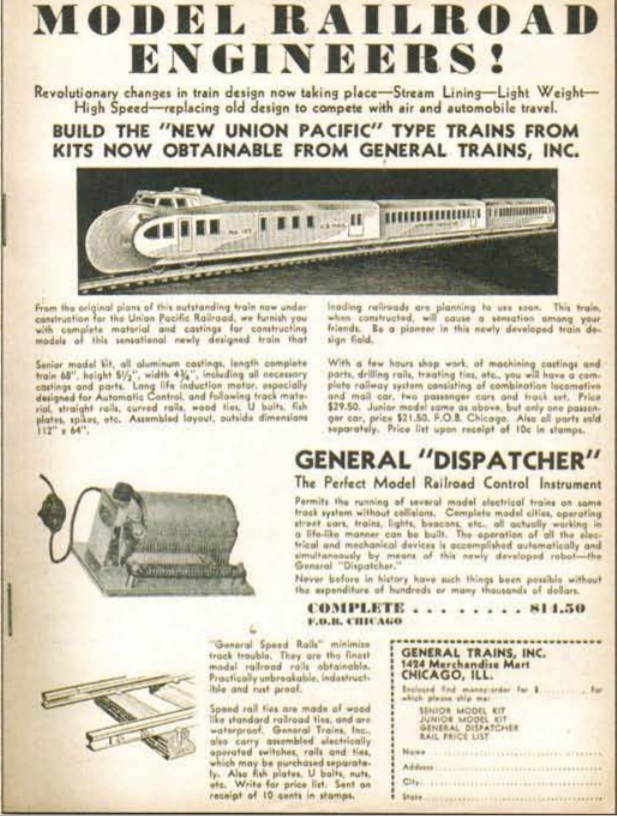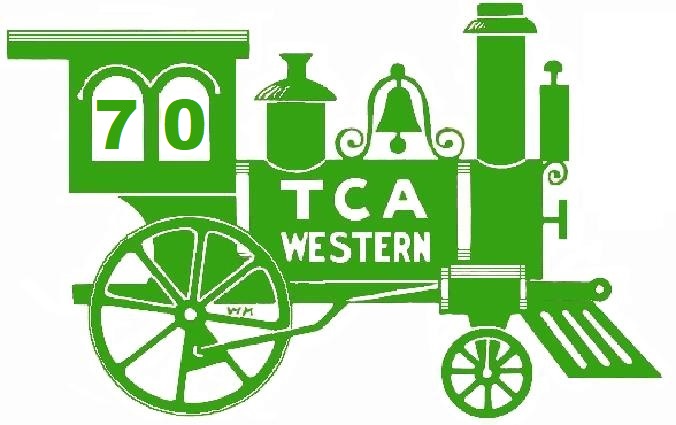History
General Trains, Inc. of Chicago, Illinois created two distinctive cast aluminum streamliner sets of the Union Pacific
M-10000 type passenger train circa 1933. Harry Carpenter Stearns, a Chicago-area consulting engineer, was the
originator of the idea to mass produce a ½" scale replica M-10000 based on early drawings leaked by the railroad.
It was offered for 2-rail operation on a unique track gauge that was slightly wider than
Lionel's Standard gauge as either 3-car or 2-car sets with power unit, an oval of the company's
'Speed Rail' (12 pieces of track) and a transformer. The company was announced to the world via
an ad appearing in Model Craftsman's February 1934 issue. The company was only in business from 1933-39.

In 1933, the Union Pacific Railroad was moving forward with a new concept in train design: the "streamliner".
Advance promotion of this radical departure was accompanied by a great deal of hype, not to mention preliminary
artist's images of these "revolutionary changes in train design." Those early drawings would prove to be substantially
different from the trains that actually rolled into service the following year, but the Chicago manufacturer that called
itself General Trains Inc. couldn't have foreseen that. General Trains raced into production with a wide gauge model of
the "new Union Pacific type trains" before anyone had seen the real thing. Although very short-lived, their trains
would come to hold several places of unique distinction in the pre-war wide gauge world: the only streamliner;
only use of aluminum for train, motors, or track, and only two-rail operation.

Harry Stearns first created wood mold patterns in order to sand-cast the streamliner body and motor
components with the intention of producing 500 sets. Stearns wanted to beat the competition to the market. The introduction
of the General Trains Inc. Union Pacific M-10000 streamliner occurred prior to releases by famous toy and model train
manufacturers Lionel, Louis Marx & Co., and
American Flyer. However, as a result of Union Pacific altering the design of their prototype M-10000,
General Trains Inc. later also altered their model's design.
At a time when even Lionel was beginning to see the writing on
the wall for the larger trains in Standard gauge, General Trains jumped in with both feet. They created mammoth cast aluminum
passenger cars powered by entirely new aluminum frame motors on insulated aluminum wheels rumbling across two-rail aluminum
track. Each car body was of cast aluminum with thickness from ⅛" to ¼". Silver trim panels were unpainted
aluminum inserted into the castings. The cars measure roughly 21 to 23 inches long each. A 3-car set with power unit is 85
inches in length. Car width is 4½ inches and height is 7½ inches. Each car had a lighted interior. Original
wiring utilized for supplying the electricity to the power unit components and for the interior car lighting is easily
identifiable with its cloth insulation. A set of male and female connectors was added to the ends of the car wiring to
facilitate disconnection. The only component that they didn't design and fabricate to their own specific need was the
foot-long coiled steel spring that holds each articulated car tightly fitted into the next. These springs were readily
available at the local hardware store as they were used to pull screen doors closed! The AC motors employed in these trains
was of the induction type. Induction electric motors have no brushes or commutator.
 Stearns chose to produce 2-rail track rather than 3-rail. The unique 2-rail track system featured both straight and curved
sections that were 2 feet in length. Aluminum solid rail was nailed to each wooden tie using metal spikes. Track sections were
joined by tiny prototypical frog plates using nuts and bolts and a special hex-head nut driver. All the track was made of
aluminum. No crossings or switches were created initially, but one specialized piece of straight track came with the 64" by
112" oval included in each set. General Trains Inc. did offer its track for separate sale in both prefabricated as well as in
kit form. Aluminum rail could be acquired in 6' lengths.
Stearns chose to produce 2-rail track rather than 3-rail. The unique 2-rail track system featured both straight and curved
sections that were 2 feet in length. Aluminum solid rail was nailed to each wooden tie using metal spikes. Track sections were
joined by tiny prototypical frog plates using nuts and bolts and a special hex-head nut driver. All the track was made of
aluminum. No crossings or switches were created initially, but one specialized piece of straight track came with the 64" by
112" oval included in each set. General Trains Inc. did offer its track for separate sale in both prefabricated as well as in
kit form. Aluminum rail could be acquired in 6' lengths.
The special track section that was included in General Trains sets facilitated operation of the
trains at 2 different speeds. Mounted on a wood plate extending from beneath the rails, a simple lever switch pivoted between
two brass screw heads. The included transformer was not equipped with a rheostat, but did provide both a high and a low power
setting via two separate terminals, along with a third 'common' terminal. With the common wire attached to one of the frog
plate bolts, lines from the high and low power terminals went to the two screws on the lever switch section of track. The
operator could move the track switch lever to make contact with either the slow or fast brass screw head contact.
The 1934 General Trains Inc. Model Craftsman ad stated that the train came in kit form as a 3-car
standard set #397 priced at $29.50 or as a 2-car 'Junior Model' set #132 for $21.50. There was also a General Dispatcher
transformer advertised at $14.50. The General Dispatcher was promoted in the ad as the perfect model railroad control
instrument. Its function was to enable running of multiple electric trains on the same track system while automatically
avoiding collisions. The General Dispatcher could automatically operate the trains and accessories in a programmed
sequence using a series of reed switches tripped in order on a rotating drum. It is unknown how many of these devices were
built and sold, but they are very rare and difficult to find today. An almost identical device was also offered by the
Western Coil and Electric Company of Racine, Wisconsin, makers of an 'O' gauge model of the
Burlington Zephyr streamliner in the 1930's. There is a belief among hobbyists that Harry Stearns designed the Dispatcher
device, but that it was produced by Western Coil and Electric.
Even though the General Trains ads from 1933-34 tout their trains as being offered in kit form, it
is beleived that they only sold them fully assembled and ready-to-run. The trains could be ordered in a variety of paint
colors or in a natural aluminum finish. Each General Trains set was serially numbered. A serial number was etched on the
underside of each car, into either the casting or the sheet metal plate near the truck mountings. Each component within a
set bore the same serial numbers. Based on research of General Trains sets in collections and appearing for sale,
it is estimated that production totals were in the 500 set range. These General Trains Inc. Streamliner sets were too
expensive to be successfully marketable given the economics of the 1930's and the Great Depression, thus the reason
for a short lifespan of the company. As a result, there are very few models still in existence, and collectors consider
them to be quite valuable, due to their rarity and uniqueness of design and operation.
Harry Stearns contracted orders for his M-10000 sets from both Gimbels and Marshall Field & Co.
department stores. Despite small production and a short commercial life, General Trains was apparently working on the
"next steps." A metallic blue set exists that demonstrates more than just a deviation from the standard metallic
dark pink paint. This set has a taller version of the power motor; and the nose casting is likewise different to accept
the tall motor frame. It bears three different set numbers: nose unit #41, center unit #157, and tail unit #196.

An entirely different General Trains set also was made, using completely different nose and tail car
castings that are much closer in appearance to the streamline trains that actually went into service on the nation's
railroads. Painted yellow and brown with the same decals as the standard production, these sets utilized the same "short"
motor as their bulbous pink brethren. Unlike all of those other sets however, they bear no engraved set numbers on the
underside of their castings. This set is typically found with only a power unit and a tail unit. The yellow and brown
painted set is sometimes found in a variation that has a more Union Pacific M-10000 like appearance as the power unit has
porthole windows instead of the more common square windows. Several of these "prototype" sets are known to exist.

For collectors, the General Trains streamliners are a desirable oddball. Even in a substantial
collection of Standard Gauge, non-collectors invariably single them out for admiration and questions far disproportionate
to their- rarity or collector value. For those who operate Standard Gauge, these pink behemoths offer both special
challenges and rewards. The fiber gear that transfers power from the armature to the wheels is remarkably susceptible
to wear. And that sturdy original track is something of a necessity as no other manufactured two-rail track can withstand
the pounding, especially the lateral weight and pressure on curves. But the look and sound of these trains slithering
across a layout and clanking loudly when their articulated segments snap together are unlike anything in railroading!
In recent years, hobbyists and antique toy train collectors have shown a strong interest in obtaining
these rare General Trains Inc. streamliners. At a May 8, 2021 Cottone Auction of the collection of Al & Kathy Kolberg
of Illinois, a hammer price of $3,000 was achieved for a 'Junior Model' set #132.

Content for this article was gathered from the following sources:
Train Collectors Quarterly July 2007 (Vol.53, #3) "100 years of Standard Gauge" by John DeSantis
Classic Toy Trains Magazine March/April 1990 "General Trains Union Pacific M-10000 Streamliners" by Bob Thon
General Trains Inc. photos and knowledge contributed by model train and toy collector John Smatlak
Back To Top of Page

